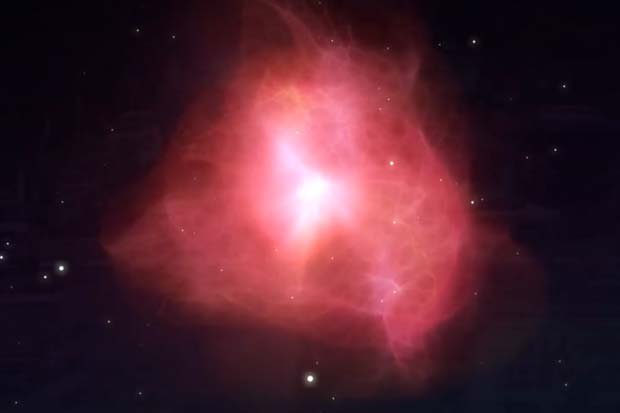A Long-Lost Gas Cloud Will Slam into Our Galaxy in 30 Million Years

A massive cloud of gas will crash into the Milky Way in about 30 million years, but there's no real danger to our home galaxy, NASA says.
New observations by NASA's Hubble Space Telescope suggest that the gas, called Smith's Cloud, was cast from the Milky Way long ago. A new NASA video describes the cloud's discovery in 1963 and what researchers know.
"We don't fully understand the Smith Cloud's origin," Andrew Fox, an astronomer at the Space Telescope Science Institute who led the research, said in a statement from NASA. "There are two leading theories. One is that it was blown out of the Milky Way, perhaps by a cluster of supernova explosions. The other is that the Smith Cloud is an extragalactic object that has been captured by the Milky Way." Fox's team examined the cloud using Hubble's Cosmic Origins Spectrograph, and saw evidence of sulfur, which absorbs ultraviolet light from the cores of three galaxies lying beyond the cloud. The team found that the amount of sulfur in Smith's Cloud is the same as that found in the outer disk of the Milky Way, suggesting that both objects came from the same family. [Stunning Photos of Our Milky Way Galaxy (Gallery)]
"The cloud appears to have been ejected from within the Milky Way and is now falling back," Fox said. "The cloud is fragmenting and evaporating as it plows through a halo of diffuse gas surrounding our galaxy. It's basically falling apart.
"This means that not all of the material in Smith's Cloud will survive to form new stars," he added. "But if it does survive, or some part of it does, it should produce an impressive burst of star formation."
It's still unclear what event tore this cloud from the Milky Way's disk and how it stayed together so long, NASA officials said in the statement. What is known, however, is that in roughly 30 million years, it will crash into our galaxy's Perseus Arm, one of the two major spiral arms in the Milky Way. When that happens, there will be a surge of star formation when clouds of gas in the spiral arm are compressed, NASA officials said.
Follow Elizabeth Howell @howellspace, or Space.com @Spacedotcom. We're also on Facebook and Google+. Original article on Space.com.
Get the Space.com Newsletter
Breaking space news, the latest updates on rocket launches, skywatching events and more!
Join our Space Forums to keep talking space on the latest missions, night sky and more! And if you have a news tip, correction or comment, let us know at: community@space.com.

Elizabeth Howell (she/her), Ph.D., was a staff writer in the spaceflight channel between 2022 and 2024 specializing in Canadian space news. She was contributing writer for Space.com for 10 years from 2012 to 2024. Elizabeth's reporting includes multiple exclusives with the White House, leading world coverage about a lost-and-found space tomato on the International Space Station, witnessing five human spaceflight launches on two continents, flying parabolic, working inside a spacesuit, and participating in a simulated Mars mission. Her latest book, "Why Am I Taller?" (ECW Press, 2022) is co-written with astronaut Dave Williams.









